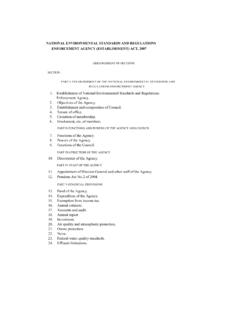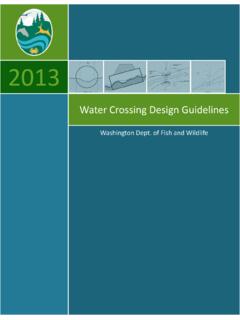Transcription of Overview of CWSRF Eligibilities
1 Overview of Clean Water State Revolving Fund Eligibilities May 2016. Table of Contents Introduction 1. How to Use This Paper 2. CWSRF Program Eligibilities 3. Section 603(c)(1) Eligibility: Section 212 4. Section 603(c)(2) Eligibility: Section 319 4. Section 603(c)(3) Eligibility: Section 320 4. Section 603(c)(7) Eligibility: Section 122 6. Project Categories 7. Centralized Wastewater Treatment 8. Energy Conservation 10. Water Conservation 12. Stormwater 13. Agricultural Best Management Practices 14. Decentralized Wastewater Treatment 15. Resource Extraction 16. Contaminated Sites 17. Landfills 18. Habitat Protection and Restoration 19.
2 Silviculture 20. Desalination 21. Groundwater Protection and Restoration 22. Surface Water Protection and Restoration 23. Planning/Assessment 24. Overview of Clean Water State Revolving Fund Eligibilities Introduction The Clean Water State Revolving Fund ( CWSRF ) program can fund a wide variety of water quality protection efforts. The program's flexibility and broad range of project Eligibilities enable states to target CWSRF funds to their specific water quality priorities. State innovation and statutory changes have resulted in an evolution of project Eligibilities since the program was authorized in 1987 (Figure 1). This paper provides a current Overview of CWSRF project Eligibilities .
3 The program was established in 1987 with three statutory Eligibilities : the construction of publicly owned treatment works (POTWs), the implementation of a state nonpoint source (NPS). management program, and the development and implementation of a National Estuary Program (NEP) Comprehensive Conservation and Management Plan (CCMP). In 1996, EPA published The Clean Water State Revolving Fund Funding Framework (Funding Framework), which articulated a process for identifying and prioritizing nontraditional projects in an effort to move toward a watershed approach. Building on the solid foundation laid by the Funding Framework, EPA completed the final draft of The Clean Water State Revolving Fund Program: Tapping Its Untapped Potential (White Paper) in October 2007.
4 The White Paper is a compilation of the many nontraditional CWSRF Eligibilities under the original statutory authority. In 2009, the American Recovery and Reinvestment Act (ARRA) created the Green Project Reserve, which increased the focus on green infrastructure, water and energy efficiency, and environmentally innovative projects. Most recently, the CWSRF was amended by the Water Resources Reform and Development Act (WRRDA) of 2014, which further expanded the program's Eligibilities . The 51 state programs have the flexibility to direct funding to their particular environmental needs. In addition, each state program may have its own statutes, rules, and regulations that guide project Eligibilities .
5 This paper represents a set of examples of what may be eligible at the national level. Within these parameters, each state program will determine what projects and borrowers are eligible to receive assistance. Figure 1: CWSRF Eligibilities timeline 1|Page How to Use This Paper The paper is organized into project categories. Use the table of contents to quickly navigate to the category of interest. Some activities are relevant to more than one project category;. however, each activity is only discussed once to avoid repetition. In these situations, there are references to the other relevant sections of the paper. Examples of eligible projects for a given project category are organized into call out boxes.
6 The nuances of when projects are eligible based on ownership, regulatory status, and type of borrower are provided in the bulleted list. Information within each project category is organized by eligibility. Because there is overlap between many of the Eligibilities , projects are only listed as eligible under the most specific authority to avoid repetition. 2|Page CWSRF Program Eligibilities To be eligible for CWSRF assistance, a project must meet the criteria of one of the eleven CWSRF Eligibilities . Section 603(c) of the Clean Water Act (CWA) states that the CWSRF can provide assistance: (1) to any municipality, intermunicipal, interstate, or State agency for construction of publicly owned treatment works (as defined in section 212).
7 (2) for the implementation of a management program established under section 319;. (3) for the development and implementation of a conservation and management plan under section 320;. (4) for the construction, repair, or replacement of decentralized wastewater treatment systems that treat municipal wastewater or domestic sewage;. (5) for measures to manage, reduce, treat, or recapture stormwater or subsurface drainage water 1;. (6) to any municipality, intermunicipal, interstate, or State agency for measures to reduce the demand for publicly owned treatment works capacity through water conservation, efficiency, or reuse;. (7) for the development and implementation of watershed projects meeting the criteria set forth in section 122.
8 (8) to any municipality, intermunicipal, interstate, or State agency for measures to reduce the energy consumption needs for publicly owned treatment works;. (9) for reusing or recycling wastewater, stormwater, or subsurface drainage water;. (10) for measures to increase the security of publicly owned treatment works (11) to any qualified nonprofit entity, as determined by the Administrator, to provide assistance to owners and operators of small and medium sized publicly owned treatment works (A) to plan, develop, and obtain financing for eligible projects under this subsection, including planning, design, and associated preconstruction activities; and (B) to assist such treatment works in achieving compliance with this Act.
9 The majority of the eleven Eligibilities refer to measures that attain an objective; however four Eligibilities reference other sections of the CWA ( , Section 212, Section 319, Section 320, and Section 122). Those four Eligibilities have additional criteria that must be considered when determining if a project may receive CWSRF assistance. Criteria for those four Eligibilities are summarized below. 1. Subsurface drainage is an underground collection system ( , sewer, tile drain, etc.) used to manage overland flow of water ( , stormwater, irrigation water, etc.). Depending on the type of collection system, subsurface drainage may be a point source or nonpoint source of pollution.
10 3|Page Section 603(c)(1) Eligibility: Section 212. POTWs, as defined in Section 212 of the CWA, are eligible for CWSRF assistance. The eligibility criteria for Section 603(c)(1) projects are: Projects must be consistent with the definition of treatment works as set forth in Section 212. Projects must be publicly owned, as required by CWA Section 603(c)(1). Only capital projects ( , construction activities, equipment purchase) are eligible. The CWSRF cannot fund ongoing operation and maintenance activities; however, planning and design for capital projects, as well as broader water quality planning where there is a reasonable expectation that the planning will result in a capital project, are eligible.













